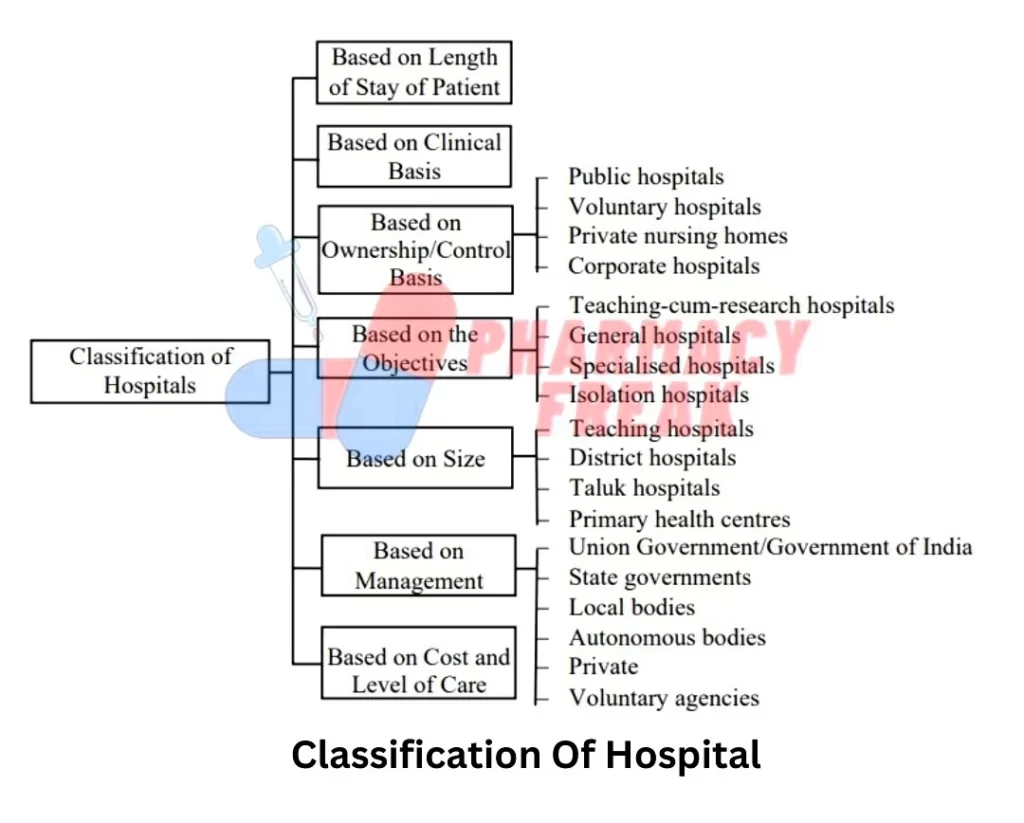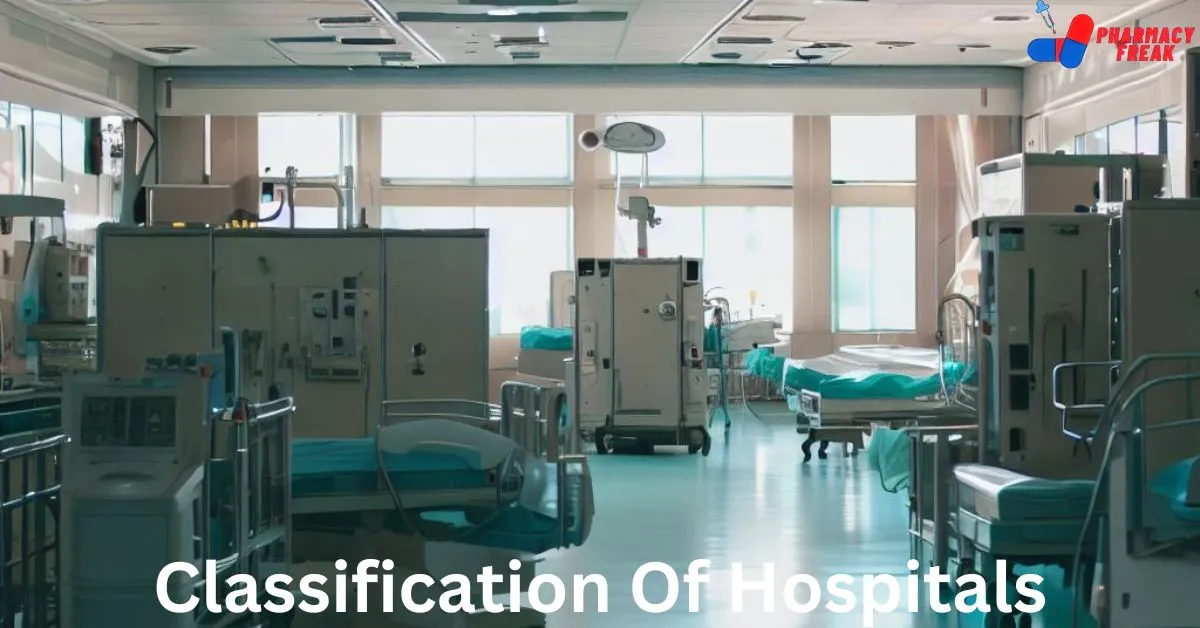Definition of Hospital
Hospital is a complex organisation. It is an institute of providing health to individuals with the help of complex and special scientific equipment in the presence of trained staff who are well-educated in the problems of modern medical science.
For achieving the goal of maintaining a good health of individuals suffering from diseases and relieving them from pain, all the staff members of hospitals coordinate together. Hence, hospital is a specialised organisation in which patient care is the main focus.
In modern hospitals, there is ample of space and well -qualified and skilled personnel who provide curative, restorative, and preventive services of extreme quality to all the patients irrespective of their race, colour, creed, or financial status.
As per WHO, “Hospitals are reservoirs of critical resources and knowledge. They can be classified according to the interventions they provide; the roles they play in the health system and the health and educational services they offer to the communities in and around them.
Classification of Hospital
All the hospitals have different features as they vary in their structure, functions, performance, and the community it helps. Hospitals are classified into different types based on different standards.

Classification Based on Length of Stay of Patient
In a hospital, a patient stays for a short term for the treatment of acute diseases (e.g., pneumonia, peptic ulcer, gastroenteritis, etc.), while for the treatment of chronic diseases (e.g., tuberculosis, leprosy, cancer, psychosis, etc.) a patient stays in the hospital for a long term. Thus, on this basis of short term and long term, the hospitals are categorised into:
- Acute Care Hospitals
- Chronic Care Hospitals
Classification Based on Clinical Basis
Hospitals categorised based on these criteria are general hospitals which cure all types of diseases. However, they are mainly focused on curing heart disease, cancer, ophthalmic, maternity, etc. conditions.
Classification Based on Clinical Basis done on their anatomical, physiological specialisation.
- ENT (Ear, Nose and Throat) hospitals
- Eye hospitals
- Orthopaedic hospitals
- Kidney hospitals.
Hospitals are classified as follows based on the client group they serve:
- Paediatric hospitals for children
- Gynaecological hospitals for women
- Maternity hospitals for mothers.
Hospitals are classified as follows based on the system of medicine adopted for treatment:
- Allopathic hospitals
- Ayurvedic hospitals
- Homeopathic hospitals
- Unani hospitals
- Hospitals of other systems of medicine.
Classification Based on Non-Clinical Basis
Hospitals on non-clinical basis are classified as follows:
Classification Based on Ownership/Control Basis
- Public Hospitals: These hospitals are under the control of Central or State Governments or local bodies on non -commercial lines. They can be general hospitals or specialised hospitals or both.
- Voluntary Hospitals: These hospitals are recognised and combined under the Societies Registration Act 1860 or Public Trust Act 1882 or any other act of Central or State Governments. They are supported by the public or private funds on a non-commercial basis.
- Private Nursing Homes: These are regulated by an individual doctor or a group of doctors on a commercial basis. Patients suffering from infirmity, advanced age, illness, injury, chronic disease, disability, etc. are admitted here. However, patients having communicable diseases, alcoholism, drug addiction, or mental illness are not treated.
- Corporate Hospitals: These hospitals are public limited companies running on commercial lines and formed under the Companies Act. They can be general or specialised or both.
Classification Based on the Objectives
- Teaching-cum-Research Hospitals: These are the hospitals having a college for education of medical, nursing, dental, or pharmacy. Teaching is the major aim of these hospitals and the provision of healthcare is secondary. AIIMS (New Delhi), PGIMER (Chandigarh), JIPMER, (Pondicherry), KR Hospital (Mysore), Victoria Hospital (Bangalore), etc. are some examples of teaching-cum-research hospitals. General Hospitals: These hospitals help for curing the common diseases. They have at least two or more doctors, who can offer in -patient accommodation and provide medical and nursing care for more than one category of medical discipline, such as general medicine, general surgery, obstetrics, gynaecology, paediatrics, etc. Their primary aim is to provide medical support to the people, and teaching and research are secondary. Examples of these hospitals are all districts and Taluk or PHC or rural hospitals.Specialised Hospitals: These hospitals provide medical and nursing care for one discipline or a disease or a condition of one system. They concentrate on a particular aspect or body organ and give medical and nursing care in the particular field, e.g., tuberculosis, ENT, ophthalmology, leprosy, orthopaedics, paediatrics, cardiology, mental health/psychiatric, oncology, STDs, maternal, etc.
- Isolation Hospitals: These hospitals treat patients who are suffering from infections and communicable diseases and need to be isolated. Epidemic diseases hospital (Bangalore) is an example of isolation hospital. 3)
Classification Based on Size (Bed Strength)
According to the Health Committee Report, the following pattern of development of hospitals should be accepted on the basis of size:
- Teaching Hospitals: These hospitals have 500 beds and can be increased depending on the number of students.
- District Hospitals: These hospitals have 200 beds and can be increased up to 300 depending on the population.
- Taluka Hospitals: These hospitals have 50 beds and can be increased depending on the population.
- Primary Health Centres: These hospitals have 6 beds and can be increased up to 10 depending on the needs.
Classification Based on Management
Hospitals based on this criteria can be sub – divided as follows:
- Union Government/Government of India: These hospitals are controlled by the Government of India. Hospitals run by the railways, military/defence, mining or public sector activities of Central Government are the examples of such hospitals.
- State Governments: These hospitals are controlled by the state or union territory. Government authorities and public sector activities running through the state or union territories comprising the police, prison, irrigation department, etc. are the examples of such hospitals.
- Local Bodies: These hospitals are managed by the local bodies, such as municipal corporation, municipality, Zila Parishad, Panchayat, e.g., corporation maternity homes.
- Autonomous Bodies: These hospitals are formed under a special act of parliament or state legislation. They are financially supported by the Central/State Government/Union territory. AIIMS (New Delhi), PGIMER (Chandigarh), NIMHANS (Bangalore), KMIO (Bangalore), etc. are some examples of such hospitals.
- Private: These hospitals are run by an individual or by private organisation. MAHE (Manipal), Manipal Hospital (Bangalore), Hinduja Hospital (Mumbai), etc. are some examples of such hospitals.
- Voluntary Agencies: These hospitals are run by a voluntary body, a trust, or a charitable society registered under a suitable authority under Central/State Government laws. They include hospitals run by missionary bodies and cooperatives. CMC hospital (Vellore) is an example of such hospital.
Classification Based on Cost
Hospitals based on this criteria can be sub-divided as follows:
- Elite Hospitals: These hospitals are a symbol of high -tech medical development. The per day room rates vary between Rs 300-1200. The deluxe rooms have fridge, television, and telephone. Excluding the medical care, they are similar to five -star hotels, thus, are also called five-star hospitals. These institutions reserve a particular percentage of their capacity for poorer sections and also support a particular percentage of their accommodation cost. For example, Jaslok has reserved 25% for the poorer sections and 30% at half the rates. In Mumbai hospital, 315 beds out of 680 are free and 112 beds are funded.
- Budget Hospitals: These hospitals are for moderate budget and low budget users, e.g., civil hospitals, corporation hospitals, etc.
Classification Based on the Level of Care
- Primary Hospitals: These hospitals denote the first level of contact between the individuals (including their families) and the health system. According to Alma Ata Declaration of 1978, primary health care indicates serving the community it served; including mother and child care, which comprised of family planning, immunisation, prevention of locally endemic diseases, treatment of common diseases or injuries, delivery of essential facilities, health education, pro vision of food and nutrition, and adequate supply of safe drinking water. Primary healthcare in India involves a network of sub-centres and primary health centres in rural and urban areas, which are provided through health posts and family welfare centres. A sub -centre has one auxiliary nurse midwife and multipurpose health worker. It provides services to around 5000 users in plain areas and 3000 in hilly and tribal areas. The Primary Health Centre (PHC) having a medical officer and other paramedical staff serves 30,000 users in plain areas and 20,000 in hilly, tribal and backward areas. Each PHC supervises 6 sub-centres.
- Secondary Hospitals: These hospitals are provided by such medical specialists, who do not have direct contact with the patients, like urologists, dermatologists, cardiologists, etc. According to National Health System Policy, a patient proceeds further for secondary care after being referred by a primary care professional. A patient cannot directly move to secondary care as sometimes health systems impose a restriction of referral on a patient in terms of payment; however, this varies from countries to countries.
- Tertiary Hospitals: These hospitals are a third level of health system. They provide a specialised consultative care to a patient referred from primary and secondary medical care. Specialised intensive care units, advanced diagnostic support services, and specialised medical personnel are the key features of tertiary health care. Tertiary care service in India is provided by medical colleges and advanced medical research institutes.

I am a Registered Pharmacist under the Pharmacy Act, 1948, and the founder of PharmacyFreak.com. I hold a Bachelor of Pharmacy degree from Rungta College of Pharmaceutical Science and Research. With a strong academic foundation and practical knowledge, I am committed to providing accurate, easy-to-understand content to support pharmacy students and professionals. My aim is to make complex pharmaceutical concepts accessible and useful for real-world application.
Mail- Sachin@pharmacyfreak.com
